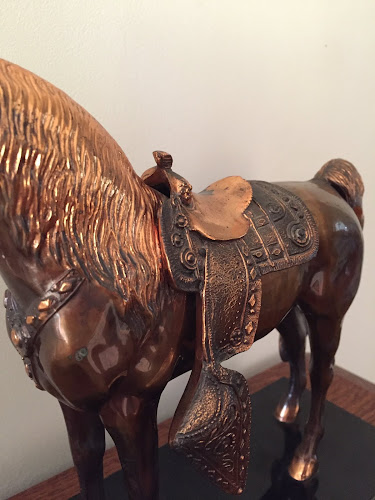Southern California used to be a very, very horsey place. So when I can, and when it's safe, I attend yard sales and estate sales that offer items related to that slice of equine history.
This morning my face mask and I visited an indoor/outdoor estate sale that offered several items designed by the eminent equine historian, researcher, author, and artist Gladys Brown Edwards. I wasn't able to find any evidence that the people who had owned the items ever met Gladys; that's not surprising, though, because the items at the sale were mass-produced for horse lovers.
(If you're not familiar with Gladys, I will share a link to more information on her at the bottom of this post.)
Of the GBE items at the sale, I came home with a handsome metal horse figurine with detailed Western tack. It appears in Carolyn Martin's book Gladys Brown Edwards' Equine Works in Metal (link at the bottom of the post).
The horse suffered some ear and leg damage over the years, but its personality still shines. And you can see the level of detail Gladys put into the design.
A friend of mine also stopped by the sale, and she picked up a pair of the Thoroughbred bookends Gladys designed. (Here's an example of one.)
The most interesting piece at the sale was one that I don't have the space, or budget, or even a reason to want to own. It was the life-size fiberglass Quarter Horse that Gladys designed for Prewitt's. The earliest examples of this date to the early 1960s.
This wasn't the first time I've encountered a Gladys Brown Edwards Quarter Horse at an estate sale. A couple of years ago, I purchased an original GBE pencil sketch from the estate of a man who worked at several horse publications in the 1940s-50s.
It was published in the June-July 1949 issue of Horse Lover's magazine.
The estate sale company ad said the big fiberglass horse had stood for years at the historic Pickwick Stables in Burbank, California.
The Pickwick Stables were legendary in the local horse community in their day. The property was located next to the what is now the Los Angeles Equestrian Center, and across the freeway from Griffith Park and the Autry Museum. The earliest reference I found to Pickwick Stables online was a Los Angeles Times article from 1933. It was a mecca for horse lovers for many decades.
Los Angeles Times, 15 February 1933.
Pasadena Star-News, 5 June 1942.
The Valley Times, 20 February 1960.
But the age of the horse in Southern California wound down. Pickwick Stables was turned into condominiums in the late 1970s, and only condo residents' horses could be stabled there.
Los Angeles Times, 24 August 1980.
The fiberglass Quarter Horse designed by Gladys was far too large to fit on my bookshelves. A local gentleman purchased it and took it home, lying on its side and carefully tied to the top of his car.
When I got home, I shared the information about the sale with my colleagues in the Facebook group "The Art of Gladys Brown Edwards." There was some discussion in the group about whether the fiberglass horse's now-peeling pinto paint job was his original color. The answer is no, because, miraculously, one of the group members who used to ride at Pickwick had a photograph of our reinforced plastic friend in situ, circa 1972.
There he is, on top of the breezeway, in his original color!Photos of Pickwick Stables shared with the kind permission
of equine history researcher Dolores "Dee" Adkins.
We know more about Gladys Brown Edwards' relationship with the fiberglass Quarter Horse because of published accounts. The Quarter Horse was produced by Prewitt's, a firm established by Bob Prewitt of Lawndale, California.
Los Angeles Times, 4 February 1962.
For more information on Prewitt's, we can also refer to Gladys Brown Edwards' papers, which are part of the collection at the W. K. Kellogg Arabian Horse Library (WKKAHL) at Cal Poly Pomona.
Gladys also designed an Arabian and, I believe, a Thoroughbred for Bob Prewitt. I took this photo of a photo of her with the Arabian design at the WKKAHL exhibit "Becoming Gladys Brown Edwards" a few years ago.
The horse is not as ubiquitous as it used to be in Southern California. But there's still plenty of evidence of its influence on our culture, and of the people who loved horses, if you know where to look.
___________________________________________________________________________
Here's another blog post I wrote on a metal Gladys Brown Edwards horse figurine. This article has more background information on GBE.























Years ago, the Western Horseman Magazine printed a series of photos. Mr. Dobbins, owner of the great Appaloosa stallion Bright Eyes Brother, had hired a Name Brand horse artist (my old brain refuses to produce the name, although I know it well) to paint one of the Prewitt GBE QH molds as a portrait.
ReplyDeleteThe first pix showed the stallion standing calmly as the artist made the final touches. Then BEB, turned his head and looked curiously at the model. The horse was allowed to approach his portrait, and stood nose to nose -- then he bowed up his neck(you could see the guys around him laughing at his interest-- and then BEB obviously spun around, jerking away from his handler, and blasted the interloper with both barrels! The background showed men in chaos and the fiberglass "BEB"flying into the air!
Definite proof of how realistic GBE's sculpture could be.
:-D
What a great story!
DeleteI'm reasonably sure I grew up with a pair of those bookends. They look so familiar.
ReplyDelete